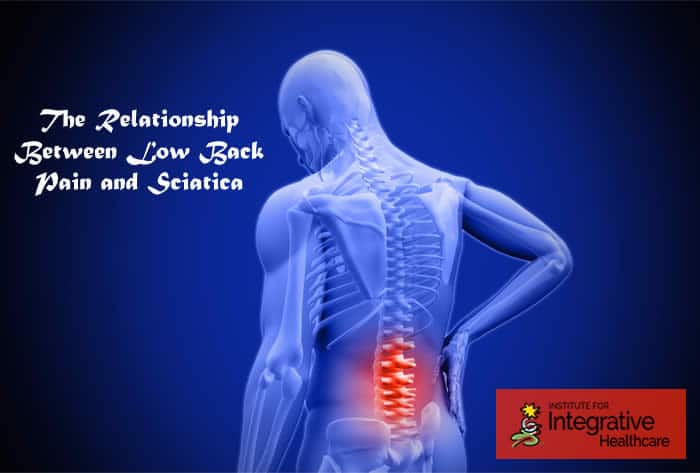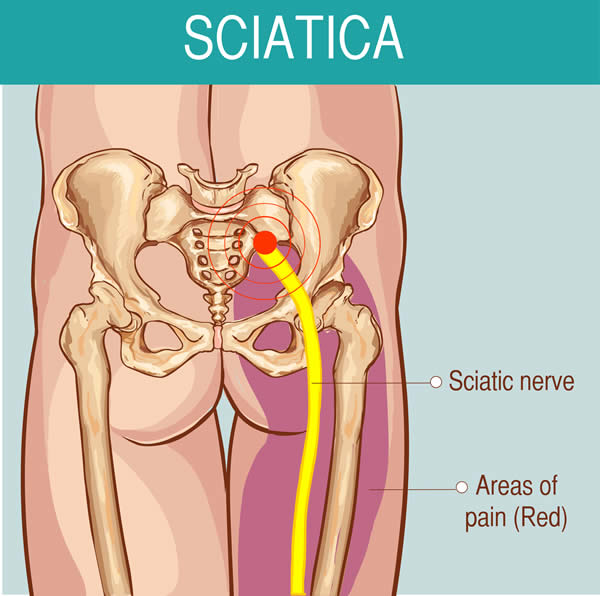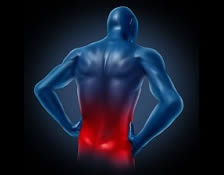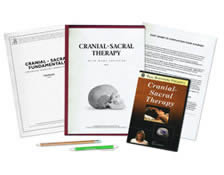

To assist clients with experiencing low back pain, it is important for a massage therapist to understand a correlating relationship between their back pain and sciatica conditions. Quite often, low back pain and sciatica conditions are related.
Defining Low Back Pain
The lumbar spine consists of five vertebral bones. The bones in this spinal segment have larger vertebral bodies to better bear body weight. Over half of one’s weight is carried at the Lumbar 5 (L5) and Sacrum (S1) articulation. With more weight added to this vertebral joint, compressive forces also increase. A study in the Journal of Biomechanics published in 2015 showed that compression within L5-S1 increased between 46-52% with load holding tasks and 80-147% with no load in hands when body weight increased from 51 to 119 kg. (1)
With more compressive force upon the lumbar spine, muscles and surrounding structures must maintain greater integrity to withstand the increased force demand. This will strain muscles, tendon and ligaments. Both sensory and motor nerve supply may be impinged from this region. If the L5 spinal nerve becomes impinged, sensory and/or motor deficits may be witnessed within the hamstrings, knees, calves and feet.
RICE and PRICE
Traditionally, the RICE method of injury recovery was the standard thought-process of aiding musculoskeletal pain. RICE is a mnemonic indicating Rest, Ice, Compression and Elevation as a primary means to injury recovery. Many health professionals have added “Protect” to create the mnemonic PRICE, as one may protect an injury with splints and bandaging efforts.
MEAT
Presently, many health professionals have changed their view of RICE as the standard health care for injury recovery. Some suggest that gradually increasing movement as soon as possible after injury is now considered best way to improve one’s back health. The mnemonic MEAT arose from this new line of thought. This stands for “Movement, Exercises, Analgesics and Treatments.” The inclusion of movement prevents scar tissue from creating restrictions within the injured region as the musculoskeletal tissues heal.
Defining Sciatica Conditions
The sciatic nerve is a large nerve stemming from the lumbar plexus of nerves.

The Cleveland Clinic describes that injury to the sciatic nerve itself is rather rare, however the term “sciatica” generally refers to pain sensations felt originating in the low back which radiate down the legs. (2)
Many massage manuals further delineate types of sciatica. There are three main types of sciatica conditions generally presented in common massage manuals:
#1: True Sciatica features impingement of Sciatic nerve at Lumbar-Sacral plexus (L4 to S1 roots).
- If L4 spinal nerve is impinged, sensations experienced within the medial leg-foot, loss of dorsi-flexion ankle movement, and there is reduced knee-jerk reflex.
- If L5 spinal nerve is impinged, sensations experienced include an inability to extend great toe along with “drop foot” witnessed in gait.
- If S1 spinal nerve is impinged, sensations experienced in lateral leg-foot, loss of plantar flexion ankle movement, and there is reduced ankle-jerk reflex.
#2: Piriformis Syndrome features impingement of Sciatic nerve either between Piriformis & Superior Gemellus muscles or within the Piriformis fibers itself.
#3: Pseudo-Sciatica features impingement of Sciatic nerve other than prior two locations, usually between Gluteus Maximus & Gluteus Medius muscles.
Epidemiology (Frequency)
David Davis, et al, in his study published in StatPearls online, provides current epidemiology statistics about sciatica conditions. There is a lifetime incidence between 10-40% of general U.S. population with peak incidence witnessed between ages 40-49. Occupations which witness workers subject to awkward physical positions are most likely to acquire sciatica conditions. (3)
Classic Signs and Symptoms
- Lower back / Hip pain
- Radicular leg pain
- Burning / tingling / numbness experienced in the low back, hips and legs
- Leg muscle atrophy / weakness experienced in the low back, hips and legs
- Chronic gluteal pain
- Scoliosis developing later in life
- Reproductive organ challenges as spinal nerves S1—S5 are associated with reproductive organ function
Common Causes of Either Low Back Pain and Sciatica
The most common cause of pain in the lumbar and sacral regions is spinal nerve root impingement due to intervertebral (spinal) disc damage. A spinal disc may have one of three potential injuries.
- Bulging Discs: Also called “slipped,” a portion of the spinal disc will swell and press against surrounding spinal ligaments causing an irritating compression upon neighboring spinal nerves.
- Herniated Discs: The spinal disc sprains surrounding spinal ligaments and protrudes out of its normal space within the vertebral body borders of the spinal bone causing injury to neighboring spinal nerves.
- Degenerated Discs: The spinal disc disintegrates causing the fluid core of the disc, called the nucleus pulposus, to spill into surrounding spaces and potentially injure neighboring spinal nerves.
Aside from disc projects, there are other causes of low back pain and sciatica conditions.
Other Causes of Low Back Pain and Sciatica
Lumbar stenosis witnessing narrowing of the spinal canal, spondylosis featuring stiffening and eventual fusing of vertebral joints, and spondylolisthesis with associated spinal bone displacement may cause nerve impingement, especially at the L5—S1 junction.
Additionally, dysfunction of the Sacral-Iliac joint is a potential cause of lumbar-sacral pain. The effects of pregnancy upon the female body may also contribute to creating muscle spasms of the lumbar-gluteal unit facilitating pain.
Spinal cord injury causing neurological deficits may become a complication or may be a cause onto itself.
If lumbar-sacral pain is accompanied by:
- a loss of bladder and/or bowel function,
- progressive lower limb weakness or numbness in the upper thighs/groin
seek medical attention immediately, as complications have arisen.
Massage Therapist Considerations
Functionally, the sacrum acts in two significant manners.
- First, the sacrum acts as an anchor solidifying the vertebral column into the pelvic girdle.
- Second, the sacrum transfers gravitational and tension forces from the upper body to lower body.
These two functions make this bone significantly important in treating pain in the low back and gluteal regions.
Having taught in entry level education, I acknowledge that many students as well as general public members may have reservations about receiving massage near the sacrum—gluteal region. Never assume client consent with this region. Always obtain informed consent prior to the session. Communicate why you intend to address this region. Help your client understand that musculature here affects pain patterns and muscles elsewhere.
A massage therapist sensitive to the connection between low back and sciatic pain will address both regions mindfully. Incorporating stretching of the low back and gluteals will be a great addition to treatments. If one is skilled in cranial sacral therapy, the sacral protocol from this work can also aid greatly.













